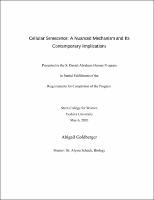Please use this identifier to cite or link to this item:
https://hdl.handle.net/20.500.12202/5633| Title: | Cellular Senescence: A Nuanced Mechanism and Its Contemporary Implications |
| Authors: | Schuck, Alyssa Goldberger, Abigail. |
| Keywords: | Senior honors thesis Cellular Senescence |
| Issue Date: | 6-May-2020 |
| Publisher: | New York, NY. Stern College for Women. Yeshiva University. |
| Citation: | Goldberger, Abigail. Cellular Senescence: A Nuanced Mechanism and Its Contemporary Implications. Presented to the S. Daniel Abraham Honors Program in Partial Fulfillment of the Requirements for Completion of the Program. NY: Stern College for Women. Yeshiva University, May 6, 2020. Mentor: Dr. Alyssa Schuck, Biology. |
| Abstract: | Cellular senescence is a unique molecular mechanism with characteristics and consequences that vary greatly across distinct physiological contexts. Definitionally, senescence represents a retreat from cellular division to a viable limbo state with altered cellular metabolism and secretory patterns. Immune clearance of the senescent unit typically follows suit. This pattern would seem to contribute to appropriate tissue turnover, a phenomenon favorable with regard to wound healing, tissue regeneration, and tumor suppression. It is therefore intriguing to consider the contributions of senescence to various disease states including age-related degenerations and even cancer itself, the very condition against which senescence is thought to be protective. To better elucidate the apparent contradictions within the conversation of senescence, this paper highlights key features of senescence as it relates to healthy embryonic development, cancer, and age-related physiological deteriorations. With a developing understanding of the outcomes that may be attributed to senescence, contemporary research seeks novel techniques to harness the positive potential of senescence and mitigate its negative effects. Since spinal cord injury (SCI) is sometimes considered to be a model of accelerated aging, an investigation was launched to consider the possible relationship between excessive cellular senescence and the long-term negative effects of spinal cord injury. Levels of p53, p27, and p16, three protein regulators of senescence, were assessed by Western immunoblotting in rat SCI models. Gene expression of IL-6, IL-1α, IL-1β, TNFα, and CXCL1, coding for proinflammatory cytokines, was measured via mRNA analyses. No significant association was ultimately achieved between SCI and altered markers of cellular senescence, indicating the low probability of a relationship between cellular senescence and spinal cord injury outcomes. |
| Description: | Senior honors thesis. Open Access. |
| URI: | https://hdl.handle.net/20.500.12202/5633 |
| Appears in Collections: | S. Daniel Abraham Honors Student Theses |
Files in This Item:
| File | Description | Size | Format | |
|---|---|---|---|---|
| Abigail Goldberger MAY2020 OA Senior Thesis.pdf | 536.71 kB | Adobe PDF |  View/Open |
This item is licensed under a Creative Commons License

